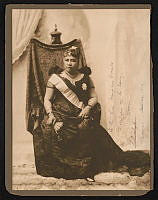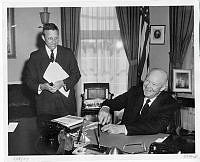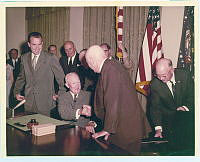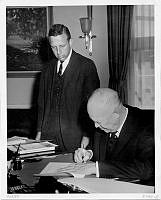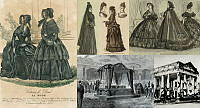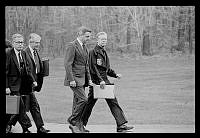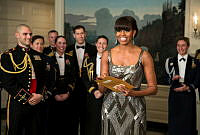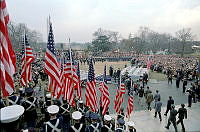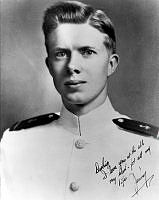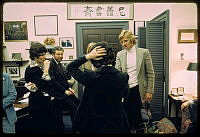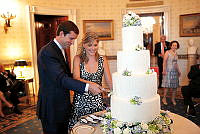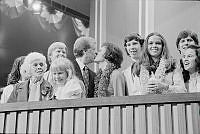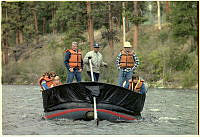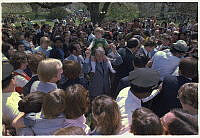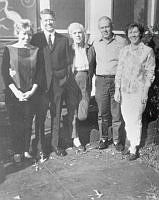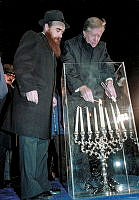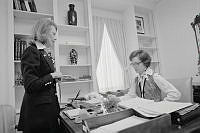Eleanor Roosevelt's "My Day": Entertainment
Copyright © White House Historical Association. All rights reserved under international copyright conventions. No part of this article may be reproduced or utilized in any form or by any means, electronic or mechanical, including photocopying, recording, or by any information storage and retrieval system, without permission in writing from the publisher. Requests for reprint permissions should be addressed to books@whha.org
The Roosevelts loved to entertain. During their thirteen-year stay in the White House, they used the mansion's grand setting to host receptions for congressmen, senators, governors, justices of the Supreme Court, foreign dignitaries, and even royalty. Less formal affairs included simple lunches or dinners with family and friends, intimate cocktail parties, teas, and game nights, as well as impromptu skits and pageants that helped enliven the atmosphere and make the White House into a true home for the president and the first lady.
As such, White House entertainment during the Franklin D. Roosevelt administration ran the gamut from elaborate public events to basic children's parties, though official gatherings generally followed a regular schedule that repeated annually. Prior to World War II, the social calendar mandated yearly receptions for the diplomatic corps, the judiciary, and the armed services as well as dinners for the cabinet, the vice president and the Speaker of the House. After taking up residence in the White House, the Roosevelts expanded this routine to include an annual dance for members of the Washington Press Corps and, beginning in 1935, a Gridiron "widows" party hosted by Eleanor Roosevelt (ER) for the recognition of newspaper women, female public officials and cabinet wives barred from the all-male Gridiron dinner.
Lacking the protocol that accompanied these formal dinners and receptions, invited teas and garden parties hosted by the first lady were a less exclusive way for the Roosevelts to greet and honor a wide variety of individuals, groups, and organizations. Youthful graduates of the Washington, D.C. public school system, for example, enjoyed the privilege of an annual invitation to tea at the Roosevelt White House in recognition of their academic accomplishments, an event, like so many others, which reflected the Roosevelts' desire to make the presidency accessible to the public and which helped to swell the number of guests that they hosted. In July 1936, the Washington Post took note of their hectic social schedule when it reported that the White House had recorded no fewer than 28,000 visitors in the previous eighteen months—a rate of more than 350 per week.
White House entertainment during the Roosevelt Administration ran the gamut from elaborate public events to basic children's parties, though official gatherings generally followed a regular schedule that repeated annually.
Unlike public entertaining, private gatherings could be either formal or informal depending upon the guest and the purpose at hand. ER, for example, often invited policymakers, aides, and activists to meals with herself, the president, or both so that they might share their opinions and plans for the future. Close-knit strategy sessions like these differed greatly in tone and purpose from the birthday parties that frequently filled the residence with song, dance, and revelry. The president himself was known to lead his guests in impromptu sing-alongs on such occasions, and his own birthday parties often featured full-fledged comedy skits with costumed friends and family standing in for professional performers.
The Roosevelts also benefitted from their close ties to the theatrical and film communities. First-run movies were a staple of private events for both children and adults. FDR, who loved Mickey Mouse cartoons, sometimes watched films to relax, though as World War II progressed he had less and less time for such diversions. Rather than cartoons, ER preferred to watch government films documenting the field work of New Deal agencies like the Civilian Conservation Corps, the Rural Electrification Administration, or the Agricultural Adjustment Administration. When the first lady did watch commercial films, however, she typically responded most strongly to those that dealt with human relationships and historical events. When she saw Gone With the Wind, for example, she noted in her newspaper column how moving she found the performances, even if "the horror of the hospital scenes seems to me dreadful."
Celebrities of all kinds came to visit the Roosevelts at the White House. Some, like opera singer Lauritz Melchior, pianist Eugene List, and flautist Rene Le Roy came purely to entertain the first couple and their guests. Others, such as actor, writer, and critic Alexander Woollcott, or the author Fannie Hurst, stayed in the mansion as personal friends of the Roosevelts. Even so, the vast majority of the celebrities who came to the White House during the Roosevelt years did so in support of the many initiatives, causes, and charities that ER and FDR supported with formal receptions and dinners. Jean Harlow and Robert Taylor, for example, were regular attendees at the annual March of Dimes luncheon held every year on FDR's birthday. After such events, ER often led visiting guests of honor on guided tours of the White House, and on at least one occasion in 1937 her celebrity guests spontaneously decided to sit at the president's desk and draft a birthday message that they left for him to discover upon his return to work.
In keeping with the Roosevelts' willingness to use official entertaining as a platform to support philanthropy and social outreach, ER often featured African American entertainers at White House performances in order to raise their profile with the general public. In 1936, she invited contralto Marian Anderson to sing at the mansion—three years before her landmark concert at the Lincoln Memorial—while baritone Todd Duncan, who originated the role of Porgy in George Gershwin's Porgy and Bess, along with the Howard University Glee Club also found their talents welcome in the environs of 1600 Pennsylvania Avenue.

President Franklin D. Roosevelt and First Lady Eleanor Roosevelt with King George VI and others at Union Station.
Franklin D. Roosevelt Presidential Library and Museum/NARAWith the onset of World War II, a different kind of guest began to visit the White House with increasing regularity as members of Europe's royal families came in search of support for their beleaguered kingdoms. Of these, the visit of King George VI of the United Kingdom and his wife, Queen Elizabeth, who arrived in Washington in June 1939 aroused the most public interest. As the first-ever reigning British monarchs to visit the United States, King George and Queen Elizabeth were the subject of intense public scrutiny, which ER chose to address in her newspaper column. Writing about one citizen's concern regarding the correct sauce to serve with a fish course, she said, "My correspondent may be soothed with the news that the fish course has been eliminated." Some interested parties even sent the Roosevelts food which they hoped could be served to the royal couple, a situation which ER said, perhaps sarcastically, "has caused frequent variation in the menus for the various meals." Despite the extensive press coverage of the trip which included a stay at FDR's boyhood home in Hyde Park, New York, ER found that interest in the royal couple remained high long after they departed. Traveling through the south three months later, ER took note of the "great interest everywhere now in the King and Queen of England's visit. How did they look, how did they act, were they as democratic as the press reports implied? These are samples of the questions asked me," she wrote. Other royal guests included Grand Duchess Charlotte of Luxembourg, Norwegian Crown Princess Martha and her three children, as well as the Dutch Queen Wilhelmina and her family, all of whom found themselves in exile due to Nazi occupation and who eventually grew quite close to the president and first lady. Of all these wartime guests, however, British Prime Minister Winston Churchill came amidst the greatest secrecy, arriving just a few weeks after the surprise bombing of Pearl Harbor in December 1941. His arrival was so confidential that FDR did not inform ER until the day of Churchill's arrival, a fact that caused her some concern upon reflection. "It had not occurred to him [FDR] that [Churchill's visit] might require certain moving of furniture to adapt rooms to the purposes for which the Prime Minister wished to use them," she wrote. Churchill, however, entered fully into the Roosevelts' life—singing Christmas carols, watching newsreels and movies, and attending a large family dinner where he and his staff tried to make sense of the Roosevelts' complicated network of relatives.
As Prime Minister Churchill's experience suggests, the rotating cast of friends, relatives, associates, and aides who surrounded the president and first lady on a daily basis might confuse anyone. What is interesting about the Roosevelts' tenure in the White House, however, is not that access to their home or their persons was limited to these select few, but rather that they welcomed the full diversity of the American public into the White House's confines. In this respect, entertainment at the Roosevelt White House remains as notable for the hospitality it extended to the anonymous as it is for the state receptions which greeted the powerful.

President Franklin D. Roosevelt and British Prime Minister Winston Churchill at their Joint Press Conference, Washington, DC.
Franklin D. Roosevelt Presidential Library and Museum/NARA












